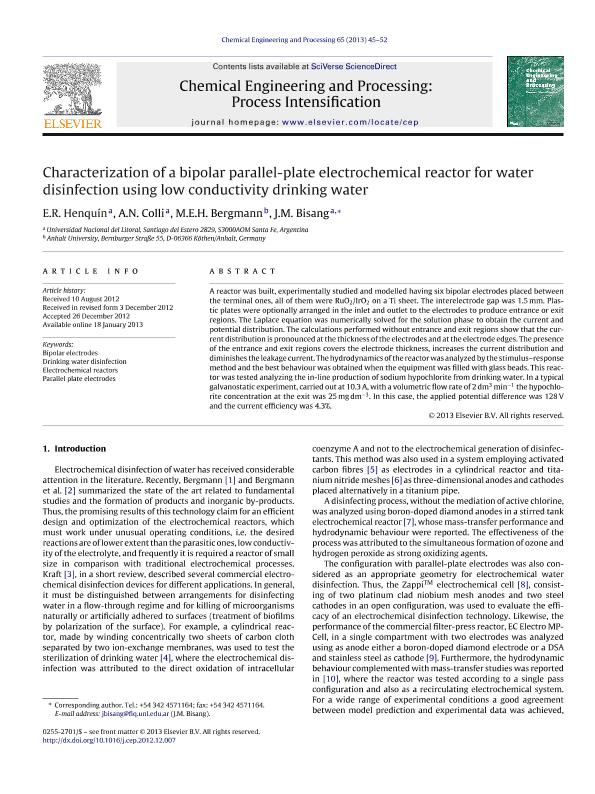Mostrar el registro sencillo del ítem
dc.contributor.author
Henquín, Eduardo Rubén

dc.contributor.author
Colli, Alejandro Nicolás

dc.contributor.author
Bergmann, M. E. H.
dc.contributor.author
Bisang, Jose Maria

dc.date.available
2016-07-07T20:18:42Z
dc.date.issued
2013-03
dc.identifier.citation
Henquín, Eduardo Rubén; Colli, Alejandro Nicolás; Bergmann, M. E. H.; Bisang, Jose Maria; Characterization of a bipolar parallel-plate electrochemical reactor for water disinfection using low conductivity drinking water; Elsevier; Chemical Engineering and Processing; 65; 3-2013; 45-52
dc.identifier.issn
0255-2701
dc.identifier.uri
http://hdl.handle.net/11336/6400
dc.description.abstract
A reactor was built, experimentally studied and modelled having six bipolar electrodes placed between the terminal ones, all of them were RuO2/IrO2 on a Ti sheet. The interelectrode gap was 1.5 mm. Plastic plates were optionally arranged in the inlet and outlet to the electrodes to produce entrance or exit regions. The Laplace equation was numerically solved for the solution phase to obtain the current and potential distribution. The calculations performed without entrance and exit regions show that the current distribution is pronounced at the thickness of the electrodes and at the electrode edges. The presence of the entrance and exit regions covers the electrode thickness, increases the current distribution and diminishes the leakage current. The hydrodynamics of the reactor was analysed by the stimulus-response method and the best behaviour was obtained when the equipment was filled with glass beads. This reactor was tested analysing the in-line production of sodium hypochlorite from drinking water. In a typical galvanostatic experiment, carried out at 10.3 A, with a volumetric flow rate of 2 dm3 min-1 the hypochlorite concentration at the exit was 25 mg dm-3. In this case, the applied potential difference was 128 V and the current efficiency was 4.3 %.
dc.format
application/pdf
dc.language.iso
eng
dc.publisher
Elsevier

dc.rights
info:eu-repo/semantics/openAccess
dc.rights.uri
https://creativecommons.org/licenses/by-nc-nd/2.5/ar/
dc.subject
Bipolar Electrodes
dc.subject
Drinking Water Disinfection
dc.subject
Electrochemical Reactors
dc.subject
Parallel Plate Electrodes
dc.subject.classification
Ingeniería de Procesos Químicos

dc.subject.classification
Ingeniería Química

dc.subject.classification
INGENIERÍAS Y TECNOLOGÍAS

dc.title
Characterization of a bipolar parallel-plate electrochemical reactor for water disinfection using low conductivity drinking water
dc.type
info:eu-repo/semantics/article
dc.type
info:ar-repo/semantics/artículo
dc.type
info:eu-repo/semantics/publishedVersion
dc.date.updated
2016-07-06T15:47:28Z
dc.journal.volume
65
dc.journal.pagination
45-52
dc.journal.pais
Países Bajos

dc.journal.ciudad
Amsterdam
dc.description.fil
Fil: Henquín, Eduardo Rubén. Universidad Nacional del Litoral; Argentina. Consejo Nacional de Investigaciones Científicas y Técnicas. Centro Científico Tecnológico Santa Fe; Argentina
dc.description.fil
Fil: Colli, Alejandro Nicolás. Universidad Nacional del Litoral; Argentina. Consejo Nacional de Investigaciones Científicas y Técnicas. Centro Científico Tecnológico Santa Fe; Argentina
dc.description.fil
Fil: Bergmann, M. E. H.. Anhalt University; Alemania
dc.description.fil
Fil: Bisang, Jose Maria. Universidad Nacional del Litoral; Argentina. Consejo Nacional de Investigaciones Científicas y Técnicas. Centro Científico Tecnológico Santa Fe; Argentina
dc.journal.title
Chemical Engineering and Processing

dc.relation.alternativeid
info:eu-repo/semantics/altIdentifier/purl/http://www.sciencedirect.com/science/article/pii/S0255270113000172
dc.relation.alternativeid
info:eu-repo/semantics/altIdentifier/doi/http://dx.doi.org/10.1016/j.cep.2012.12.007
dc.relation.alternativeid
info:eu-repo/semantics/altIdentifier/doi/10.1016/j.cep.2012.12.007
Archivos asociados
